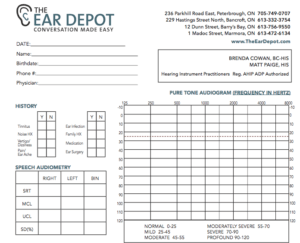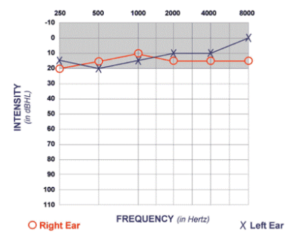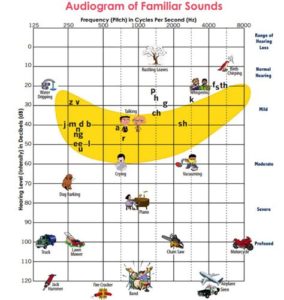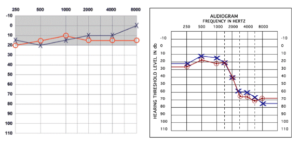How to Understand Your Audiogram

You’ve made an appointment to have your hearing tested. The Audiologist or Hearing Instrument Practitioner puts you in this booth, you hear a whole bunch of beeping sounds and then… they hand you this piece of paper with some X’s and O’s (when did this become a game of tic-tac-toe!). Welcome to your audiogram, which is a fancy term for the graph we use to record your hearing levels. So what do all these lines and symbols mean?
Lines and Symbols
At the top of the graph is the frequency (Hz) of sound or the pitch. As the frequencies go from left to right they go from low to high pitch. Vertically on the left side are decibels (dB), the intensity or the volume of the sound. As the decibel number gets bigger so does the volume and potential hearing loss. During your hearing test, we go through each pitch at different volumes to determine the softest sound you can hear. This is where the X’s and O’s come in! We mark the quietest sound you can hear for each frequency: X’s for the left ear and O’s for the right. This gives us a visual representation of where your hearing is.

Another way to think about it – Every sound, including speech [the speech banana as it’s called], is made at a particular pitch and volume. A lawnmower is rather loud at 100dB and has a low-frequency sound. The human voice can range in volume and pitch, but women’s and children’s voices tend to have a higher pitch. Based on the level of hearing loss, you could be missing certain sounds in conversation and other noises in your environment.

What is my hearing level?
The human ear is amazing; it can hear over 20,000 different frequencies! When we test your hearing, we are testing the most sensitive and important frequencies because they include speech sounds. Your hearing level is then based on the average volume that you can hear at those frequencies. The level of hearing loss gives us insight into what kinds of sounds you may be missing. The audiogram visually demonstrates the sounds you can hear and those you may be missing.
The top of the chart indicates normal hearing, the further down you go, the more challenging it is to hear or understand. Missing sounds sometimes means you can “hear” them but not understand them.
For example, in the chart on the left, that is what we consider a normal hearing range; anywhere between -10dB and 20dB (the grey area). All speech sounds and most environmental sounds can be heard.

Another example, the chart on the right, is a high-frequency moderate hearing loss. Reading the audiogram and thinking about our speech banana chart above, the final X (left ear at 8000kHz) is at about 75 dB. This means that any sound made below 75 (sounds like f, s, th, and sh, birds singing, a baby’s laugh) would not be heard.
Check out this video and listen as it demonstrates the differences in sound as the audiogram changes.
How does this information help?

Knowing your hearing level allows you to recognize what you may be missing and your practitioner to make the best suggestion for intervention so you can fully engage and converse with ease.
If you have questions about your audiogram or any other reports that are provided to you by your practitioner, don’t be afraid to ask! Having that information can help you make the best, informed decision for you and your lifestyle.



Recent Comments